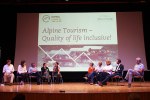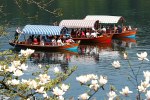News
Point of view: The tourism dilemma
How do we travel? The question is becoming ever more urgent. This, and communication in general, were the themes of the Tourism Mobility Day organised by the Federal Ministry for Sustainability and Tourism in the Austrian city of Graz in mid-May 2018. There are numerous reasons to foster sustainable mobility options for tourist destinations in the Alps.
Nowadays, 60% of all passenger kilometres in the Alps are accounted for by holiday- and leisure-related traffic, double the figure compared to the 1960s. A further increase of 30% in leisure traffic is predicted by 2030. Alpine tourism is thus destroying the very basis for its existence: the Alpine landscape, the natural diversity, the peacefulness and seclusion. The more accessible a place is, the quicker visitors can reach it – and also leave, thus losing added value.
Three-quarters of tourist CO2 emissions are due to traffic. Public transport only represents a small proportion: 84% of holiday trips in the Alps are made by private car. There are however big differences between individual countries. Public transport services are nevertheless in decline throughout the Alps, especially in rural areas. The Alpine countries prefer to concentrate more on the high-speed network for rail traffic.
But the rail system is reaching its limits, as in the case of Switzerland. Satisfying every need is a logistical and communicative balancing act: high-speed trains compete with regional transport and freight transport, not to mention air traffic. Instead of taking an overnight train to the Alps, today’s tourist will take a cheap flight to the Maldives. In this light it is hard to understand why the Alpine countries, with the exception of Austria, are cancelling their night train services.
Western European society is gradually becoming more and more aware of environmental issues, including sustainable mobility options; however, we also prize our flexibility. In this respect, no public transportation system – no matter how sophisticated – can match having your own car. The question is thus to compensate for the lack of flexibility with other benefits, which requires imagination and a spirit of innovation. While E-mobility offers interesting new possibilities, it still means a further increase in traffic volumes and energy consumption.
Sustainable mobility solutions in tourism need the involvement of local people – as hosts, as multipliers, as users. Results-oriented processes and participatory spaces to think will allow account to be taken of the various experiences and perspectives of tourists and locals. The co-operation of tourist mobility with everyday mobility will offer an even greater choice.
But new behavioural patterns are required, which in turn demand low-threshold services. The “Youth Alpine Interrail Pass” is one such offer. Developed by the CIPRA Youth Advisory Board, it encourages young people between 16 and 27 years of age to travel by train through the Alps and to record their experiences online.
Ultimately, however, we cannot avoid the question of the limits on growth in tourism. The most sustainable solution would be to stay at home – but then there would be no more tourism. At any rate, travelling to the Alps means a lesser likelihood of flying to some distant destination.
Sources and further informations:
www.bmnt.gv.at/service/kalender/Tourismus/5.-Tourismus-Mobilit-tstag-2018.html (de), www.alpconv.org/de/AlpineKnowledge/RSA/tourism/Documents/RSA4%20de%20WEB.pdf, www.cipra.org/de/alpmonitor/trends#zunehmende-mobilitaet (de,it, fr, sl), www.cipra.org/en/positions/winter-tourism?set_language=en, www.yoalin.org






